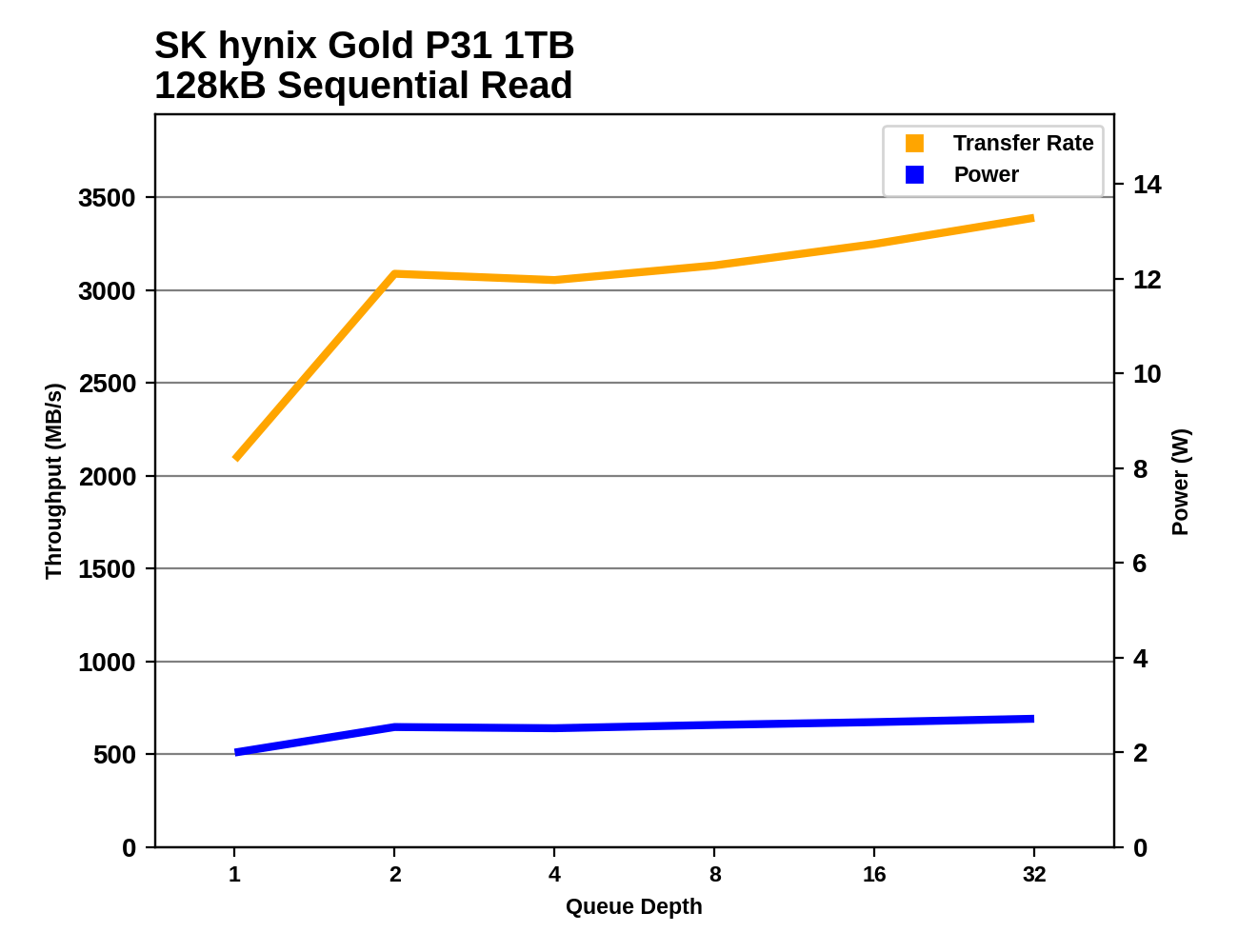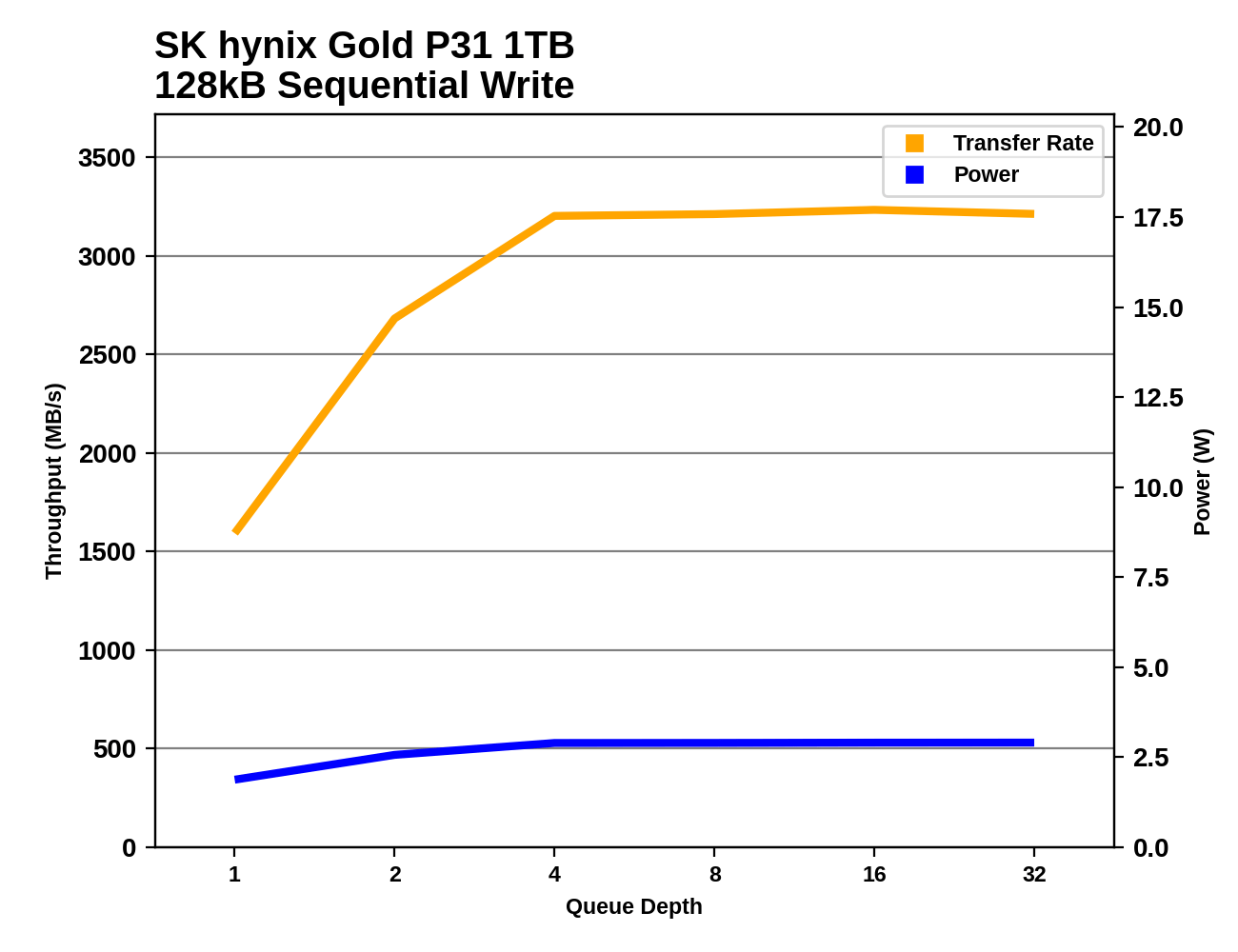The Best NVMe SSD for Laptops and Notebooks: SK hynix Gold P31 1TB SSD Reviewed
by Billy Tallis on August 27, 2020 8:00 AM ESTSequential Read Performance
Our first test of sequential read performance uses short bursts of 128MB, issued as 128kB operations with no queuing. The test averages performance across eight bursts for a total of 1GB of data transferred from a drive containing 16GB of data. Between each burst the drive is given enough idle time to keep the overall duty cycle at 20%.

The burst sequential read performance from the SK hynix Gold P31 is very good, but not quite fast enough to beat the drives based on the Silicon Motion SM2262EN controller.
Our test of sustained sequential reads uses queue depths from 1 to 32, with the performance and power scores computed as the average of QD1, QD2 and QD4. Each queue depth is tested for up to one minute or 32GB transferred, from a drive containing 64GB of data. This test is run twice: once with the drive prepared by sequentially writing the test data, and again after the random write test has mixed things up, causing fragmentation inside the SSD that isn't visible to the OS. These two scores represent the two extremes of how the drive would perform under real-world usage, where wear leveling and modifications to some existing data will create some internal fragmentation that degrades performance, but usually not to the extent shown here.

On the longer sequential read test that involves some slightly higher queue depths, the Gold P31 is basically tied for first place when reading data that was written sequentially. When reading data that has previously been fragmented by the random write test, the P31's performance is considerably higher than the other flash-based SSDs and closer to the Optane 905P.
 |
|||||||||
| Power Efficiency in MB/s/W | Average Power in W | ||||||||
In absolute terms, the power consumption of the Gold P31 isn't drastically lower than some of the other fairly efficient high-end NVMe drives like the WD Black SN750. But once performance is taken into account, the Gold P31's efficiency stands far above the competition.
 |
|||||||||
The SK hynix Gold P31 doesn't need high queue depths to deliver good sequential read throughput: at QD2 it's already above 3 GB/s, but there are further slight performance increases from higher queue depths. That performance profile is very similar to the Samsung 970 EVO Plus, but that drive requires about twice the power that the P31 uses.
Even at QD1, the sequential read performance from the Gold P31 is above the ~2GB/s limit of most other four-channel NVMe drives we've tested (with eg. Silicon Motion SM2263 based controllers). That leaves it entirely in a performance range where all the competitors are 8-channel drives that don't come close to matching power efficiency of the Gold P31.
Sequential Write Performance
Our test of sequential write burst performance is structured identically to the sequential read burst performance test save for the direction of the data transfer. Each burst writes 128MB as 128kB operations issued at QD1, for a total of 1GB of data written to a drive containing 16GB of data.

The SK hynix Gold P31 has fairly ordinary burst sequential write performance by high-end NVMe standards: tied with the SM2262EN-based ATATA SX8200 Pro but beat by the Phison-based Seagate drives.
Our test of sustained sequential writes is structured identically to our sustained sequential read test, save for the direction of the data transfers. Queue depths range from 1 to 32 and each queue depth is tested for up to one minute or 32GB, followed by up to one minute of idle time for the drive to cool off and perform garbage collection. The test is confined to a 64GB span of the drive.

On the longer sequential write test that brings in higher queue depths, the Gold P31 is tied for second place, while the Phison E16 based Seagate drive (built for PCIe 4 speeds, but limited by this testbed to PCIe 3 speeds) unsurprisingly takes first place.
 |
|||||||||
| Power Efficiency in MB/s/W | Average Power in W | ||||||||
At this point, the record-shattering power efficiency scores from the SK hynix Gold P31 are no longer a surprise. The overall fastest drive has the second best efficiency score (56% the performance per Watt of the P31) and the next two most efficient drives are much slower NVMe drives from Toshiba/Kioxia.
 |
|||||||||
The Gold P31 doesn't reach its full sequential write speed until QD4, while several of its competitors saturate at QD2. However, once the P31 is at full speed, it has one of the best sustained write speeds, and shows no sign of its SLC cache running out at any point during the test. Power consumption is comparable to the slowest NVMe drive that can barely hit half the throughput of the Gold P31.
Similar to the sequential read results, the P31 starts out at QD1 with high performance that almost puts it beyond what other 4-channel NVMe drives can do at any queue depth. From there, the P31 continues to redefine what's possible with an increasingly wide lead in power consumption relative to all other high-end drives we've tested.












80 Comments
View All Comments
surt - Thursday, August 27, 2020 - link
Am i the odd one out that hasn't needed to use a hard drive tool in years?HardwareDufus - Thursday, August 27, 2020 - link
i don't think so. i've been in the industry for over 30 years. back in those days, some harddrives came with error lists that you had to key into a system bios. then there were all the size limits that require creating multiple partitions... the list goes on...but I think other than running scan disk once a year and my scheduled trims.... I haven't used a harddrive tool on my personal PCs and laptops for over 8 years.
plopke - Thursday, August 27, 2020 - link
For me only once with Samsung it was needed , the other times where it was offered but not needed was crucial /sandisk for slight improved performance or compatibility. I just found it very awkward to not have a website showing specifications or support tools at all.Holliday75 - Thursday, August 27, 2020 - link
Nope. I have no updated the firmware on a SSD in 5+ years. That includes work.MikeMurphy - Friday, August 28, 2020 - link
My practice is to update firmware before I install a fresh copy of Windows. Often I'm greeted with some improved firmware for which I'm grateful. I've been happy with the support on my Crucial, Intel and Samsung drives.TheinsanegamerN - Monday, August 31, 2020 - link
Literally have never updated firmware on any SSD. Also only had issues with 1 SSD where the controller straight up died.Tomatotech - Thursday, August 27, 2020 - link
I've only ever used them as a last resort when trying to rescue a failing SSD (and I've had a couple) - they were useless anyway, might as well not bother. Both times when the drive died the manufacturer happily replaced the drive.With today's cloud tech it's easier than ever to keep a 1TB drive constantly backed up & synced (different things) to several different places. OneDrive offers 1TB, iCloud offers 2TB, etc, and usually anything apart from office docs, project files, and photos doesn't even need to be backed up.
TheinsanegamerN - Monday, August 31, 2020 - link
That only applies to the 1% who can get fiber internet. Ever try to back up 1TB of stuff over a cable connection, usually with a 3-5Mbps upload speed?For most people an external HDD is more usable as a backup method then any cloud storage.
Srikzquest - Thursday, August 27, 2020 - link
Hi Billy, I see that the benchmarks are equally compelling on the performance side as well in addition to power efficiency. Then, why its only the standard for Laptops and not Desktops. Is it due to PCIe gen4 drives on the market?Billy Tallis - Thursday, August 27, 2020 - link
The P31 is definitely a good choice for desktops, but it's not the only reasonable choice—while for laptops, it pretty much is at the moment. Since desktop users have little reason to worry about SSD power efficiency, it can make sense to go with something like a cheaper, somewhat slower Phison E12 drive or even something more low-end, because the real-world performance difference between the P31 and a decent low-end NVMe drive (or even a good SATA drive) is pretty small for most use cases. There's also the 2TB market to consider, since the Platinum P31 isn't available yet.